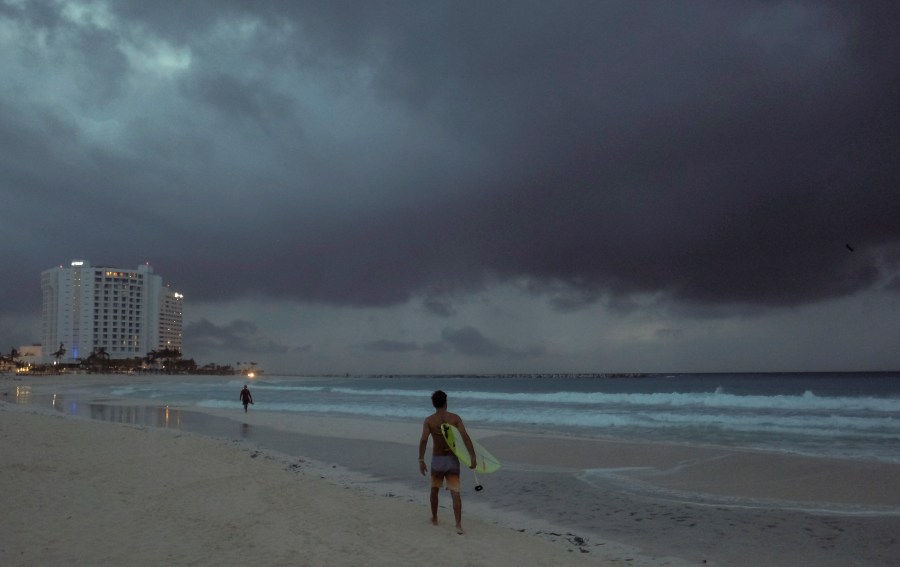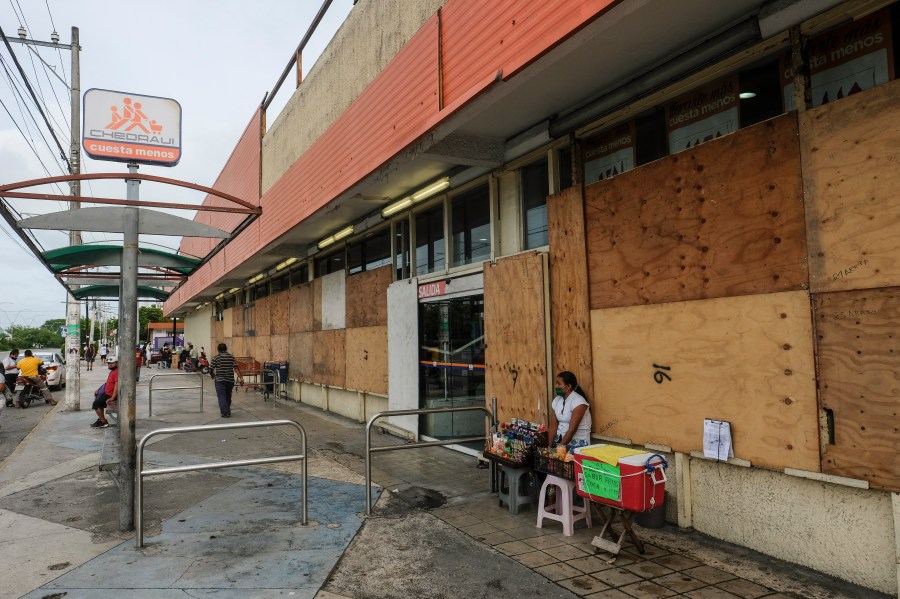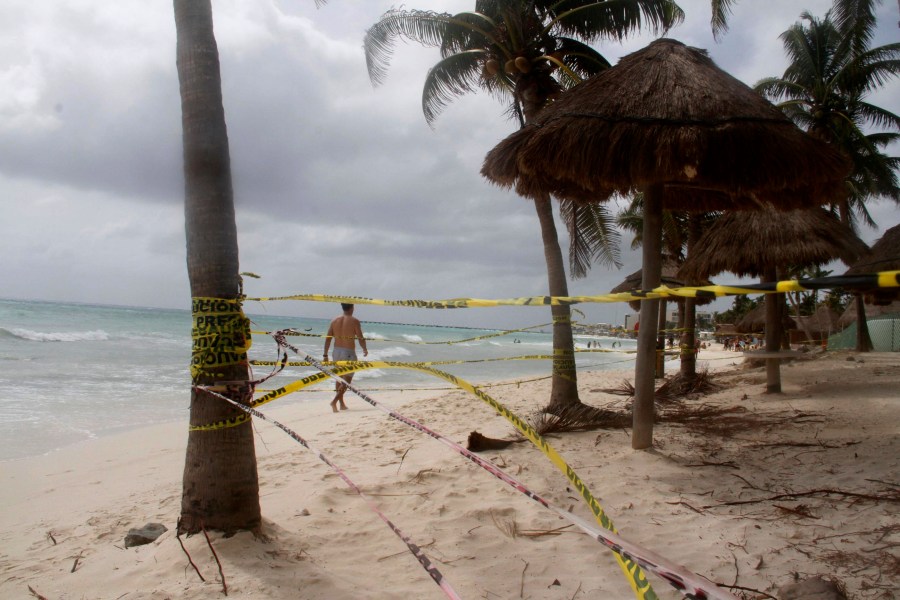At least 2 dead as Zeta batters Gulf Coast
Testing on staging11
NEW ORLEANS (AP) — A fast-moving Zeta weakened to a tropical storm as it barreled northeast Thursday morning after ripping through Louisiana and Mississippi where storm-weary residents were advised to stay indoors overnight while officials assessed the havoc the storm had wrought.
The storm raged onshore Wednesday afternoon in the small village of Cocodrie in Louisiana as a strong Category 2 and then moved swiftly across the New Orleans area and into neighboring Mississippi, bringing with it both fierce winds and storm surge. There was heavy rain at times but since the storm was so fast-moving, rain related flooding wasn’t as much of a concern.
Zeta weakened over central Alabama but its strong winds continued across portions of the state and the Florida Panhandle. The storm was about 25 miles south southeast of Tuscaloosa, Alabama, with maximum sustained winds of 70 mph. Zeta is moving quickly toward the northeast near 31 mph.
The storm killed at least two people. One was a 55-year-old man who a Louisiana coroner said was electrocuted by a downed power line in New Orleans. Capt. Jay Baker of the Cherokee County Sheriff’s Office said a large oak tree uprooted and fell through the corner of a mobile home, killing another man in Acworth. Two other adults and a child were in the home at the time of the incident but weren’t injured.
Officials said life-threatening conditions would last into Thursday in a region already pounded by multiple storms this year.
Roads were flooded near the coast, where forecasters said Zeta made landfall around Terrebone Bay near Cocodrie, an unincorporated fishing village at the end of a highway with few if any full-time residents and a marine laboratory where a building was inundated.
Streams of rainfall ran off roofs in New Orleans’ famed French Quarter, signs outside bars and restaurants swayed back and forth in the wind and palm trees along Canal Street whipped furiously. Officials said a person was hospitalized with minor injuries after a structure collapsed, but further details weren’t available.
With much of the city in the dark and more than 200 trees reported down, New Orleans Mayor LaToya Cantrell implored residents to stay home and let city officials assess the damage instead of going out and doing it themselves.
“Although we have made it through, we have been damaged, we have been hit,” she said.
More than 875,000 customers were without electricity in Louisiana, Mississippi and Alabama, including about 350,000 in metro New Orleans. Outages were mounting quickly as the storm moved northeastward across the Deep South.
Zeta had top sustained winds of 110 mph as a Category 2 hurricane at landfall and is the 27th named storm of a historically busy Atlantic hurricane season — with over a month left to go. It set a new record as the 11th named storm to make landfall in the continental U.S. in a single season, well beyond the nine storms that hit in 1916.
As much as 5 feet of Gulf water surrounded a casino in Biloxi, Mississippi, and deputies in Harrison County, Mississippi, received multiple calls from people who had remained in mobile homes that were threatened by winds.
President Donald Trump approved an emergency declaration for Mississippi Wednesday evening.
Tropical storm warnings were issued as far away as southern Virginia, highly unusual for the region. Forecasters issued a string of tornado warnings for as far east as the Florida Panhandle.
New Orleans was in the warning areas of six previous storms that veered east or west this season. This time, Zeta stayed on course.
Louisiana Gov. John Bel Edwards said in a radio interview that boats broke loose and struck a bridge in Lafitte. He said blackouts were extensive, including 94% without power in Plaquemines Parish.
“The wind has caused extensive structural damages to businesses, to homes, to electrical infrastructure,” Edwards said.
Officials had urged people to take precautions, and a business-as-usual atmosphere in the morning in New Orleans diminished as the storm neared and grew stronger. Traffic slowed, and restaurants and coffee shops shut down.
“This year, the storms have been coming back-to-back. They’ve been avoiding New Orleans but finally decided to come,” cookie shop worker Curt Brumfield said.
Winds picked up and water rose above the docks in Jean Lafitte, a small fishing town south of New Orleans that takes its name from a French pirate. Workers drove truckloads of sand to low-lying areas where thousands of sandbags were already stacked for previous storms.
“We’re going to get a lot of water fast,” said the mayor, Tim Kerner Jr.
Zeta’s wind, rain and storm surge reached more than 150 miles east of New Orleans. In Mississippi, streetlights swayed in Biloxi and the city of Pass Christian ordered all boats out of the harbor. Dauphin Island, Alabama, shut off water and sewer service in areas that typically are swamped in storms.
New Orleans officials announced that a turbine that generates power to the city’s aging drainage pump system broke down Sunday, with no quick repair in sight. There was enough power to keep the pumps operating if needed, but little excess power to tap if other turbines fail, officials said.
Forecasts called for anywhere from 2 to 6 inches of rain to fall in the New Orleans area.

Before landfall, Zeta’s top winds had risen to just shy of a major, Category 3 storm, according to the U.S. National Hurricane Center.
On Tuesday, Zeta raked across Mexico’s Yucatan Peninsula, toppling trees and briefly cutting power to more than 300,000 people but causing no deaths.
It then regained strength over the Gulf of Mexico along a path slightly to the east of those of Hurricane Laura, which was blamed for at least 27 deaths in Louisiana in August, and Hurricane Delta, which exacerbated Laura’s damage in the same area weeks later.
“I’m physically and mentally tired,” a distraught Yolanda Lockett of Lake Charles, one of about 3,600 evacuees from Laura and Delta still sheltering, said outside her New Orleans hotel.
The deteriorating weather prompted early voting sites to close for hours in the western Florida Panhandle.
Tropical storm warnings were issued for a large swath of the South, from Mississippi into Alabama and Georgia, including all of the Atlanta area, where winds could gust up to 55 mph early Thursday. Winds could be “especially severe” in the southern Appalachian Mountains, where flash flooding is possible, the hurricane center said.
Nearly 2 million customers were without power across several southern states before dawn Thursday as Tropical Storm Zeta races through the region.
According to the website PowerOutage.us, about 1.8 million were without electricity in Louisiana, Mississippi, Alabama and Georgia. Georgia has the most with more than 800,000 in the dark.
Large school systems in Alabama, Georgia and South Carolina planned to close Thursday or open late.
An average season sees six hurricanes and 12 named storms. This extraordinarily busy season has focused attention on climate change, which scientists say is causing wetter, stronger and more destructive storms.
After Hanna, Isaias, Laura, Sally and Delta, Zeta will tie a record set in 1886 and repeated in 1985 for six hurricanes smacking the continental U.S., according to Colorado State University hurricane researcher Phil Klotzbach.



